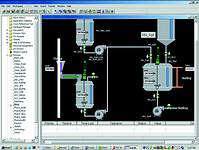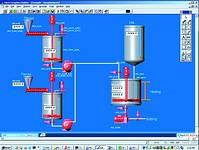
Some may have concerns that it may be prohibitively expensive to replace a dated existing control system. The good news is that technology is now available to automate this process and reduce the risks when upgrading a control system.
Technology to convert databases has been available for a number of years, but this is only a small piece of the puzzle. The majority of time and resources spent implementing a control system project is allocated to rebuilding the new operator displays. But since designing and drawing new displays for a manufacturing plant could cost many thousands of rands, having a plan to minimise upgrade costs by using an automated tool is simply good management.
The best part of having an automated tool is that it allows the re-use of all the business intelligence and production data embedded in the existing displays - avoiding the need to a second time for something already built.
Automating display upgrades involves five steps:
1. Design the look and feel of the new system.
2. Define the rules.
3. Import the legacy displays.
4. The upgrade process.
5. Test the displays.
Design the look and feel of the new system
One of the mistakes you can make when converting from a legacy system to a new control system is to maintain the same look and feel. Even though the operators may express a preference for the status quo, the reality is that it is necessary to minimise ongoing maintenance costs and this is dependent on taking advantage of the newer environment and tools. For example, a pump on the legacy system may have been represented by three separate lines and a filled circle, with some code that changed the colour. When upgrading to a new system, this should be replaced with a single symbol. Furthermore, this symbol should be linked to the source so that whenever you change the symbol on one display, the change is propagated across your entire system and applied to every instance of that particular 'pump' parameter.
Define the rules
The imported displays look exactly as they did in the legacy system, but as discussed earlier, this is not very desirable as an output. This step involves defining the rules for the conversion such that the legacy display will morph into the new look and functionality of the new system ie, is upgraded from its old to its new state. In this way all the elements of the display - static and dynamic graphics, scripts, and database connections - are translated to their equivalent on the new platform. Or to put it another way, for each project, a global export template is used that defines the parameters for the translation of the elements of the legacy display to their equivalents on the new system.


Import the legacy displays
In this step an importer converts the display from its native file format into a generic file format that allows the redefinition of the display. The 'job' of the importer is simply to import every object and property of the graphic display so that it can be manipulated.
The upgrade process
An initial (sample) batch of displays is exported to ensure that the elements and typical behaviours of the displays on the legacy system are working in the new system - then automatic bulk conversion of the displays can begin.
Test the displays
This is the most important step and although this is a manual process, inbuilt tools can simplify the process, time and effort. For example, a visual reference tool showing which items in the legacy system are static and which are dynamic, and reports that confirm accurate and error-free display conversion, help focus testing efforts.
Time to switch
Citect has been addressing this challenge for some time, and has developed a solution through its new tool called 'Switch2Citect' The tool is said to facilitate automated upgrades, not merely a replication of the existing system, but a full upgrade process.
This tool works to automate what the processes that are performed on manual display upgrades, reducing the time scale and manpower requirements significantly, while providing greater accuracy through eliminating opportunity for human error. The objective of a Switch2Citect based upgrade is for upgraded displays to look and function as if built from scratch, by a skilled operator, on the new system.
In practice a 100% automated conversion is not realistic, however for projects where a large part of the HMI/scada/DCS displays have to be recreated as far as business logic, functionality and representation of the physical infrastructure is concerned, Citect says that Switch2Citect can reduce the time devoted to display upgrades by up to 80%.
For more information contact Niconette du Toit, Citect, 011 699 6699, [email protected], www.citect.com

© Technews Publishing (Pty) Ltd | All Rights Reserved